Rainbows and Halos
Enjoy the beauty of colors in the sky, notice the different patterns, and learn how to make your own rainbow.
If you pay attention to the sky as you walk around outdoors, you can often see some lovely colors and sights. Even the background blue dome has interesting gradients for you to find. Against the blue background, you can find many kinds of fascinating and beautiful things. All of these lovely, lofty things used to be known as “meteors,” and they are all studied by the modern science of “meteorology.” And of all the meteorological phenomena, rainbows are perhaps the loveliest. However, once you have seen enough of them, you may start to notice that they come in different kinds, and deserve different names. What follows is a collection of some of my own photographs (plus a couple I found on the internet) attempting to document some of these different kinds of “rainbows.” If you keep your eyes open, perhaps you can find all of them in the skies above you (or below you).
"True" Rainbows
I'll start with the “normal” or “common” kind of rainbow, the kind you see when there are sun and rain in the same sky at the same time. In the first photo below, the ground was in shadow, but the sky above was still in sunshine, which made for a more vivid and beautiful rainbow. In the next two photos, the ground was also in sunshine. If you examine these two photos closely, can you tell which way the shadows are pointing?
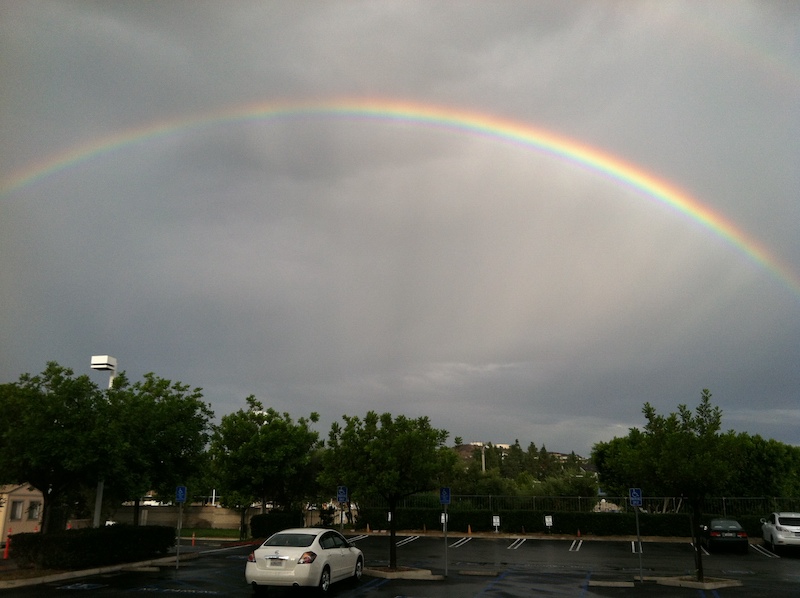


What shape are rainbows? If you are ever fortunate enough to see one just after sunrise or just before sunset, you will notice that it is very tall and almost a semicircle. If the sun is higher in the sky, then the rainbow will be a lower, flatter arc, as if more of the circle is hiding below the horizon. Have you ever seen a rainbow in the middle of the day, with the sun high in the sky? I haven't, and I'm pretty sure that you haven't either … at least not a “true” or “normal” rainbow which is always a circle on the opposite side of you from the sun. When the sun is too high in the sky, the entire circle of the rainbow is too low. It is apparently invisible, hidden completely below the horizon.
So if you pay attention to rainbows, after you've seen several examples, you might notice that they are always part of a large circle, and the circle is on the opposite side of you from the sun. You never get to see the bottom half of the circle, because it is cut off by the ground. And the higher the sun is in the sky, the lower the rainbow is and the more of the circle is below the horizon.
Do you suppose it is ever possible to see the entire circle? What about the center of the circle? Do we ever get to see if there is anything special at the center of the circle? Well, if the rainbow is caused by having the sun on one side of you, and having mist or clouds on the other side of you, then the only way to see the full circle of a rainbow would be to rise above the clouds, so you can have mist everywhere underneath you. Instead of ground below you, you need mist below you. In other words, you need to fly.
I discovered the following beautiful and informative photo on Reddit, showing an aerial photograph of a rainbow. Unfortunately, there wasn't any information about where or when it was taken. (I'm not a Reddit user myself, I just found this photo with a Google search.) By examining the photo, can you figure out what time of day it was taken? Do you notice any other beautiful and subtle features of rainbows in this photo? (See if you can find shadows of objects on the ground, and see which way they are pointing. Also, compare the inside of the circle to the outside.) If you discover anything new in this photo that you didn't notice before, can you go back to the previous photos and see if you can find the same things?
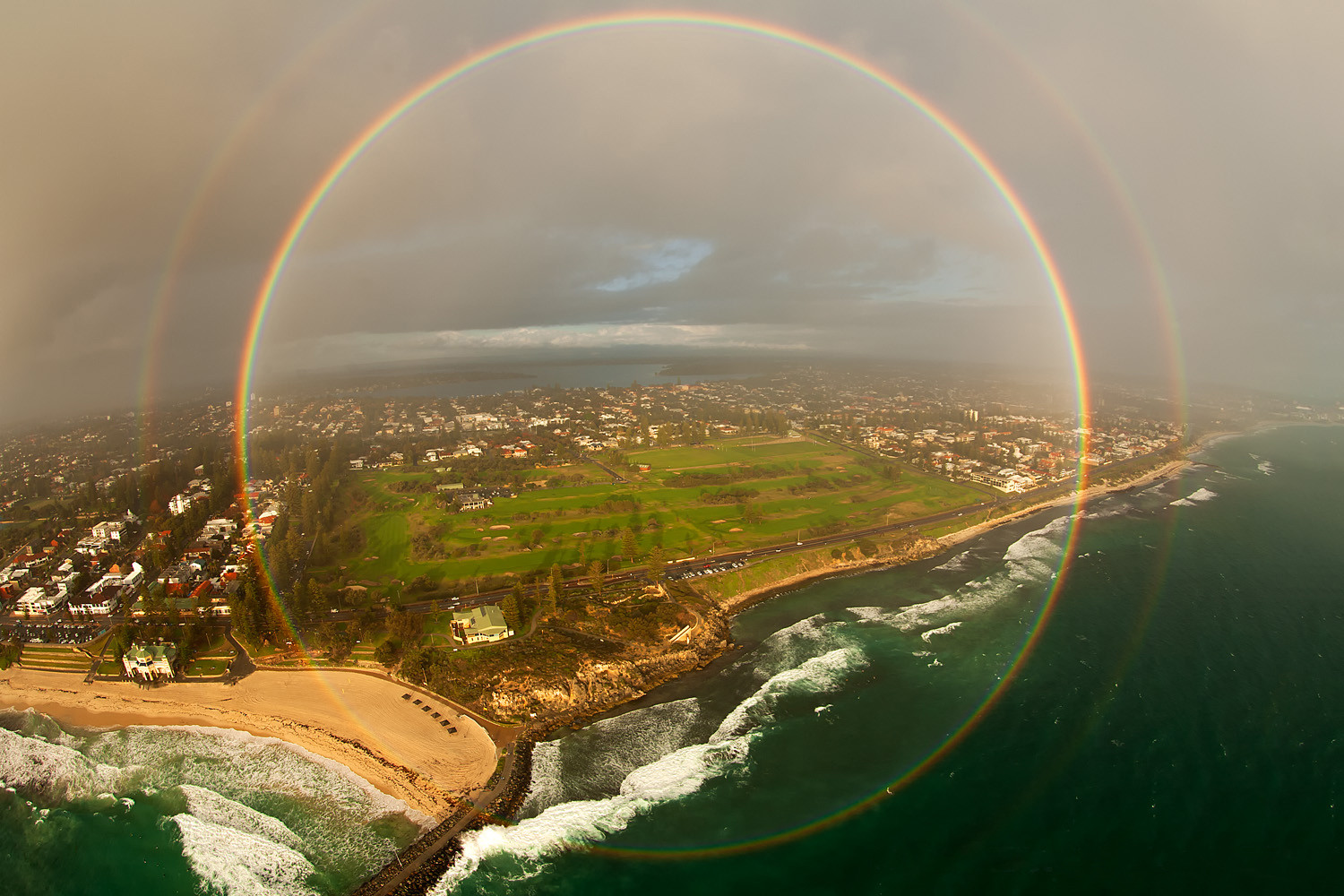
So we can see that a rainbow is actually a full circle, if we can rise above the mist. We can't see anything interesting in the center of the circle in the photo above, but that might be because we are too far away. Let's see if we can make our own homemade rainbow closer to the ground, and then maybe we can study it more closely.
Making Your Own Rainbow
What two ingredients are always in the sky whenever you see a rainbow? If you want to make your own rainbow, you will need to arrange these same two ingredients. You will need sunshine, and you will need to make a mist of some kind on the far side of you from the sun. You will also probably need a dark background, because a bright sunlit scene behind your mist will probably overpower the rainbow and make it invisible. To make a mist, a hand-held spray bottle will work, although you will only be able to see a small portion of the rainbow at one time. Sometimes you can buy “evaporative cooling” outdoor misters among the lawn and garden supplies, for cooling off your patio on a hot summer day. These work reasonably well for making rainbows, except you need a dark background behind your mist, preferably something in shade, or the colors won't be bright enough for you to see them. If you don't mind getting wet, you can also just try pressing your thumb against the end of a garden hose.
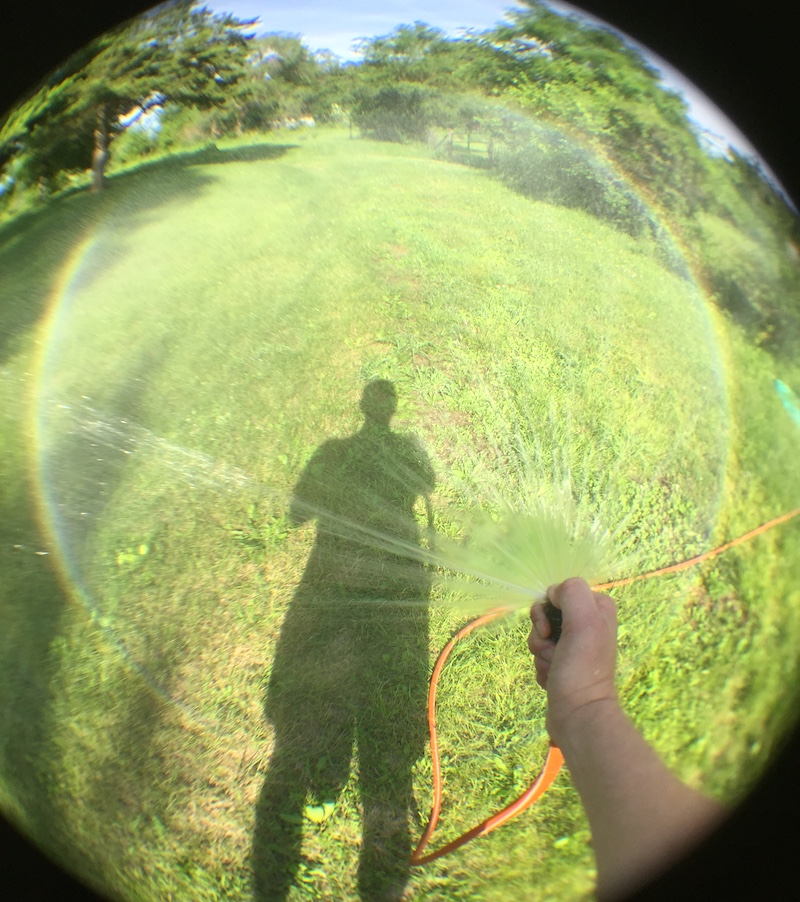
In this photograph, you can finally see what is at the center of the rainbow. In this case, it's the shadow of my head. (If you examine the photo closely, you might think the circle is actually centered on my neck. I was holding my camera at roughly neck-level.) The next time you see a rainbow, use your imagination to fill in the full circle, and find the center. If your head is in the sunshine, then the shadow of your head will be at the center of the rainbow. (In the aerial photo above, the shadow of the airplane is presumably at the center of the rainbow. It just fell on the ground too far away to see.) Rainbows are like halos around the sun, except instead of being a halo around the sun itself, it's a halo around the point on the opposite side from the sun. If you imagine the sunray coming from the sun and running through your eye and continuing out the far side, the rainbow is like a circle around that ray, but on the far side of you instead of on the sun side.
How large is the rainbow? If you point to the center of the circle with one arm, and you point to somewhere on the rainbow with the other arm, can you estimate how big the rainbow is? (More precisely, can you estimate the “angular radius”?) How much of an angle is there between the center of the circle and the edge of the circle? A square corner or a “right angle”? A half of a right angle? Perhaps you can think back to the last rainbow you saw, and remember that it was pretty large. Rainbows (at least “true” or “normal” rainbows) are so large that you can't normally photograph the whole circle, even if you can see it. The whole thing won't fit in the picture. Just look at the “normal” photographs that I started with above and imagine the full circle. To capture the full circle in a photograph, you need a “wide-angle lens,” which “squashes” a big part of the world into a smaller picture. (Or you could also make a “panorama” photograph, which most mobile devices can do nowadays.) I used a wide angle lens when I took my photograph, and whoever took the aerial photo above must have, as well.
Halos and Sundogs
Sometimes you might notice some colorful lights in the sky, but they are clearly different from “normal” rainbows. For example, sometimes if there are thin misty clouds on a cool night, you can see a wispy halo around the moon. Sometimes these halos are even colorful, like a rainbow, except the colors aren't as vivid as a normal rainbow. They are a little faded and “washed out.” The geometric arrangement is also different, because you can clearly see what is at the center of the circle — the moon itself. This “rainbow” is really a halo around the moon. (These are lovely when you see them directly, but they are hard to photograph, because the halo is usually dim, and the moon itself overpowers the halo. This is why the moon appears pure white in the photo, and it looks more like the sun than the moon. In order to make the halo show up in the photo, I had to “overexpose” the moon. When I took this picture, I could also see a slight rainbow-like color pattern to the halo with my own eyes, but the colors are too faded to show up in the photo.)
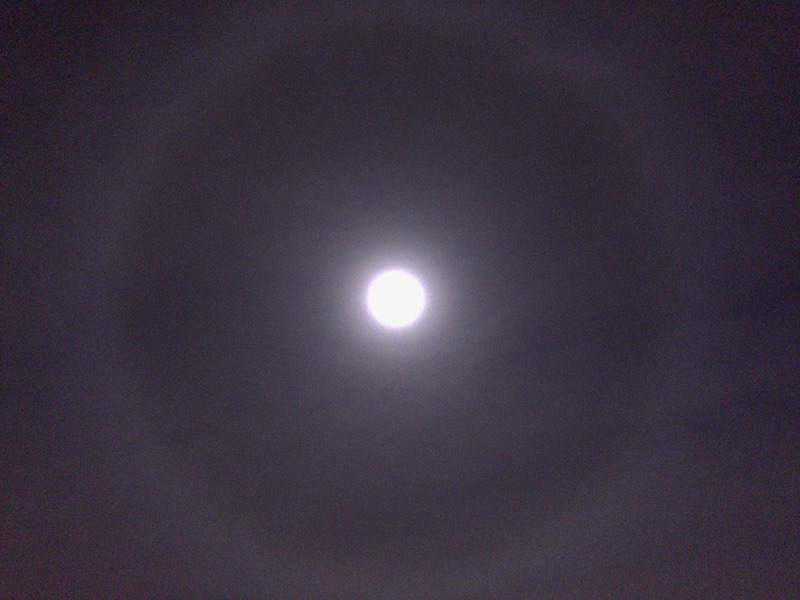
(There is also such a thing as a “moon rainbow” or "moonbow“ — which is exactly like a ”true“ rainbow, except that the sun is down and the moon is up. It's a colorful circle on the opposite side of the sky from the moon. It looks just like a ”true" rainbow except it is made by the moon instead of the sun. But those are quite rare. I've never seen one myself. You can find a few photographs of them on the internet, but the photographers have to brighten the photograph so much to see the bow, that the sky ends up looking like a normal daytime sky, and the photos end up looking almost the same as normal daytime rainbows. But perhaps you can detect some subtle differences if you study them.)
Sometimes when the weather is very cold and frosty, and the sun is low in the sky, you can see what look like slices of rainbow on each side of the sun. These are more colorful than a moon halo, and look a little more like a “normal” rainbow, but they go around the sun the way the moon halos go around the moon, and they don't even go all the way around the sun. They only appear to the sides of the sun when the sun is close to the horizon. Sometimes (depending on where the clouds are) you can only see one on one side of the sun, and not both sides. These “sun dogs” are more common in Arctic climates, but sometimes you can see them even in warm climates when there are thin wispy clouds high in the air. Sun dogs seem like they can only form in extremely frosty air, but do you suppose that maybe the air up high can sometimes be cold enough even if the air close to the ground is warm?
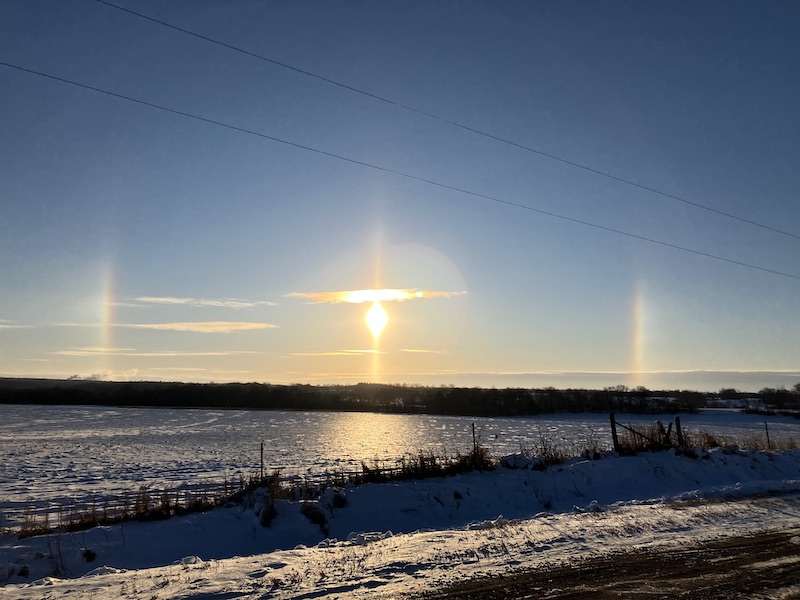
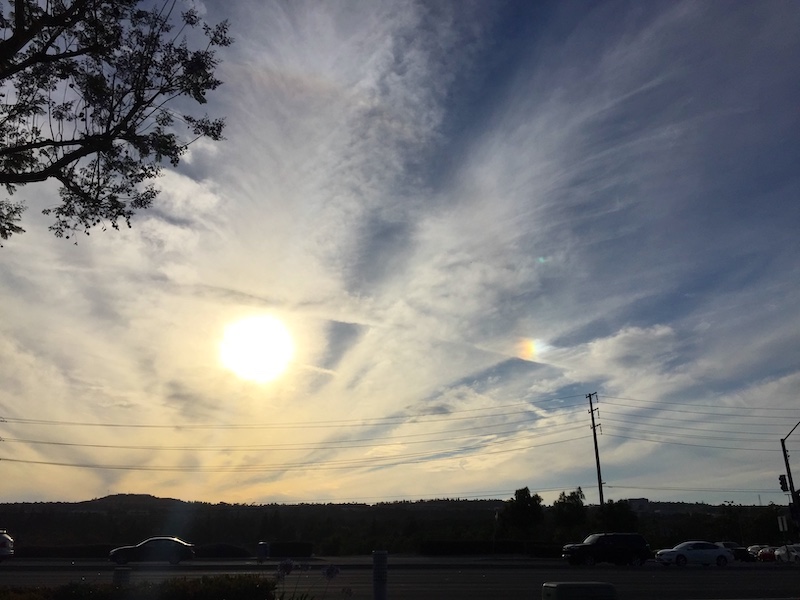
Sun dogs are officially known as "parhelia." If the air is extremely cold and clear, you might get to see that parhelia are actually just the brightest parts of a spectacular light show. Unfortunately, this doesn't usually happen unless you live in or near Arctic climates. For example, the following photograph was taken in February in North Dakota.
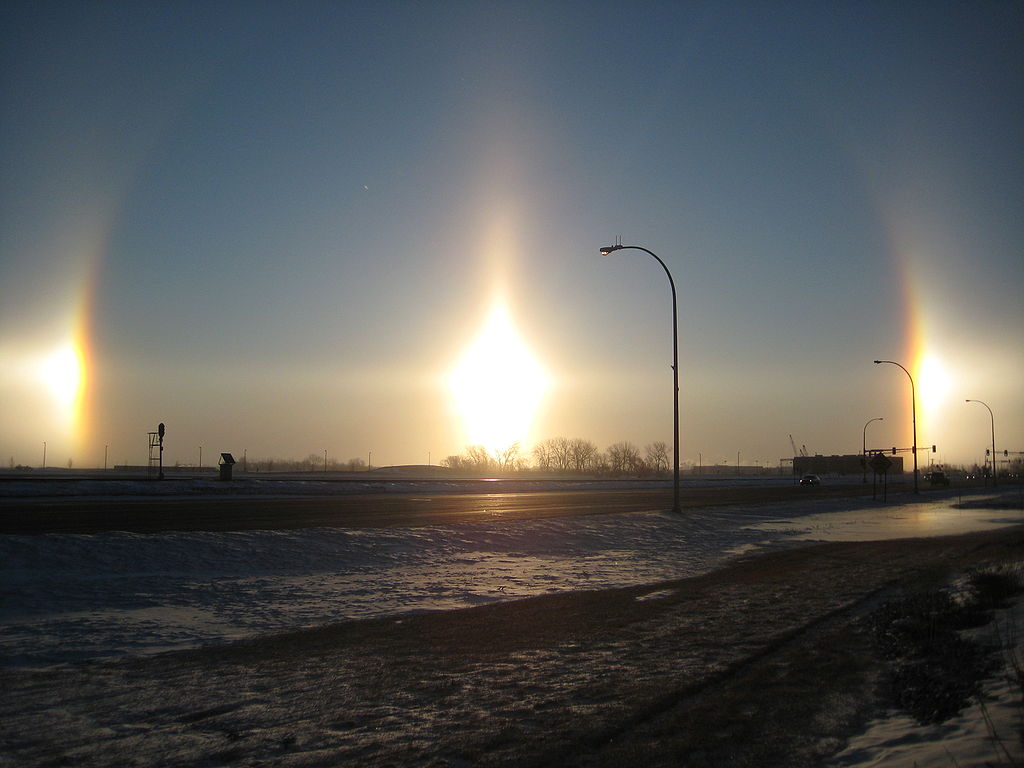
Now you can see that there really is a full halo, it just isn't very bright except at the sides. (That's officially called the "22° halo.") There is also a cross of glowing lines running through the sun. There is a horizontal ring running through the sun and all the way around the sky just above the horizon. (That's officially called the "parhelic circle“ or ”parhelic arc.") And there is a vertical "sun pillar" running up-and-down through the sun.
Here's another colorful ring that you might be tempted to call “rainbow.” Pay attention to the clouds below you the next time you fly in an airplane. Sometimes you can look down and see a tiny rainbow on the clouds. If you are close enough to the clouds to see your own shadow (meaning the shadow of your airplane), you might see that your shadow is in the exact center of the circle. The halo is a tiny circle around your shadow. Do you see a difference between these “mini rainbows” and “true” rainbows?

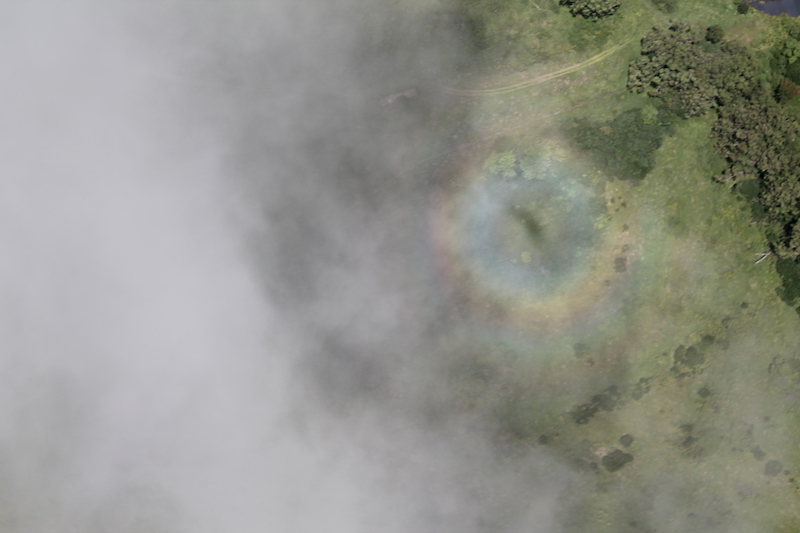
The full circle of a normal rainbow is huge. The “mini rainbows” that you can see from airplanes are much tinier. If you point towards the center with one arm, and point towards the edge of the circle with the other arm, both of your arms will pointing in almost the same direction. These “mini rainbows” must be created a little differently from the “normal” rainbows that you see from the ground. (These “mini rainbows” are officially known as glories.)